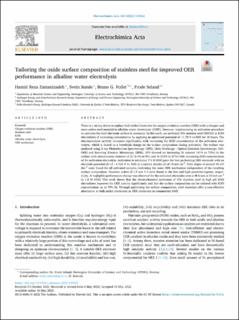| dc.contributor.author | Zamanizadeh, Hamid Reza | |
| dc.contributor.author | Sunde, Svein | |
| dc.contributor.author | Pollet, Bruno | |
| dc.contributor.author | Seland, Frode | |
| dc.date.accessioned | 2023-01-16T09:55:33Z | |
| dc.date.available | 2023-01-16T09:55:33Z | |
| dc.date.created | 2022-05-18T22:55:38Z | |
| dc.date.issued | 2022 | |
| dc.identifier.citation | Electrochimica Acta. 2022, 424 . | en_US |
| dc.identifier.issn | 0013-4686 | |
| dc.identifier.uri | https://hdl.handle.net/11250/3043619 | |
| dc.description.abstract | There is a strong desire to replace bulk nickel electrodes for oxygen evolution reaction (OER) with a cheaper and more active steel material in alkaline water electrolyser (AWE). However, implementing an activation procedure to optimize the steel electrode surface is necessary. In this work, we activated 316 stainless steel (SS316) in KOH electrolytes of increasing concentration by applying an optimized potential of +1.70 V vs RHE for 18 hours. The electrocatalytic activity increased significantly with increasing the KOH concentration of the activation electrolyte, which is linked to a beneficial change in the surface composition during activation. The surface was analysed using X-ray Photoelectron Spectroscopy (XPS), Glow Discharge - Optical Emission Spectroscopy (GD-OES) and Scanning Electron Microscopy (SEM). XPS showed an increasing Ni content (41% to 73%) in the surface with simultaneous removal of Cr (3.4% to 0%) and Fe (55% to 27%) with increasing KOH concentration of the activation electrolyte. Activation in minimum 7.5 M KOH gave the best performing OER electrode with an electrode potential (E) of +1.525 V vs. RHE at a current density (j) of 10 mA cm-2. Tafel slopes of around 40 mV dec-1 were found for all activated samples, indicating the same OER mechanism independent of the resulting surface composition. Reaction orders of 1.5 and 1.3 were found in the low and high potential regions, respectively. A negligible performance change was observed for the activated electrodes over a 48 h test at 10 mA cm-2 in 1.0 M KOH. This work shows that the electrochemical activation of 316 stainless steel in high pH KOH electrolytes improves the OER activity significantly and that the surface composition can be tailored with KOH concentration up to 73% Ni. Through optimizing the surface composition, steel materials offer a cost-effective alternative to bulk nickel electrodes as OER electrodes in commercial AWE. | en_US |
| dc.language.iso | eng | en_US |
| dc.publisher | Elsevier Science | en_US |
| dc.relation.uri | https://www.sciencedirect.com/science/article/pii/S0013468622007204?via%3Dihub | |
| dc.rights | Navngivelse 4.0 Internasjonal | * |
| dc.rights.uri | http://creativecommons.org/licenses/by/4.0/deed.no | * |
| dc.title | Tailoring the oxide surface composition of stainless steel for improved OER performance in alkaline water electrolysis | en_US |
| dc.title.alternative | Tailoring the oxide surface composition of stainless steel for improved OER performance in alkaline water electrolysis | en_US |
| dc.type | Peer reviewed | en_US |
| dc.type | Journal article | en_US |
| dc.description.version | publishedVersion | en_US |
| dc.source.pagenumber | 10 | en_US |
| dc.source.volume | 424 | en_US |
| dc.source.journal | Electrochimica Acta | en_US |
| dc.identifier.doi | 10.1016/j.electacta.2022.140561 | |
| dc.identifier.cristin | 2025411 | |
| dc.relation.project | Norges forskningsråd: 257653 | en_US |
| dc.relation.project | Norges forskningsråd: 295864 | en_US |
| cristin.ispublished | true | |
| cristin.fulltext | original | |
| cristin.qualitycode | 2 | |

